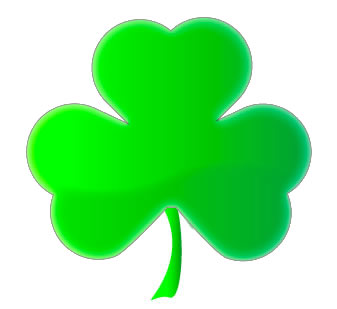
MAYFIELD, Ky. (BP) — Around St. Patrick’s Day in the last few years, I have noticed in some instances the replacement of the three-leaf shamrock symbol with the four-leaf clover. Since the shamrock is linked in the popular imagination with the Christian doctrine of the Trinity, is this yet another example of some in general society dismissing a Christian symbol? As an Irish-American Christian, I have also asked myself — is this cultural phenomenon something I should be concerned about?
Before I begin this discussion, I should point out that the legend that St. Patrick used the shamrock to illustrate the Trinity is not true and is a relatively modern legend (see my Baptist Press article, “Baptists and St. Patrick” in 2008, http://www.bpnews.net/bpnews.asp?id=27634).
Prior to the genesis of the St. Patrick shamrock legend of the 17th and 18th centuries, however, Gothic churches of the middle ages portrayed the trefoil motif (a “trefoil” is any symbol with three leaves) as a symbol of the Trinity. Building on that tradition, the three-leaf shamrock became both a Christian and Irish national symbol, and the motif has appeared on nearly everything identified with St. Patrick or Irish culture for the last three centuries.
 Surprisingly, the shamrock is not solely identified with one particular plant. The Gaelic word “seamrog” is the diminutive form of “clover.” Although the traditional “white clover” (Trifolium repens) was thought to be the plant most identified with the three-leaf shamrock, many people today identify it with other clovers and even with the three-leaf wood sorrel (Oxalis acetosella). The latter plant is often sold in florist shops in March as the “shamrock” in the United States.
Surprisingly, the shamrock is not solely identified with one particular plant. The Gaelic word “seamrog” is the diminutive form of “clover.” Although the traditional “white clover” (Trifolium repens) was thought to be the plant most identified with the three-leaf shamrock, many people today identify it with other clovers and even with the three-leaf wood sorrel (Oxalis acetosella). The latter plant is often sold in florist shops in March as the “shamrock” in the United States.
Whatever three-leaf plant is promoted as the shamrock, it has been identified as an important Christian symbol in popular culture. When I was in the first grade, my own mother demonstrated the doctrine of the Trinity by using a cardboard shamrock as she related the legend about St. Patrick. I heard the same story repeated in the public schools that I attended. At a very early age, I recognized that the shamrock was both a Christian and an Irish national symbol.
Nevertheless, the shamrock has recently acquired a rival — the rare four-leaf clover. The four-leaf clover, a traditional symbol for “good luck,” possesses only a contemporary identification with Irish culture and St. Patrick’s Day. At holiday paraphernalia websites, the green four-leaf clover now competes with the shamrock.
How did the four-leaf clover acquire this status? John Melton, an English writer of the 17th century (not to be confused with John Milton), made the first literary allusion to four-leaf clovers bringing good luck. Good luck items like the four-leaf clover originate from pagan beliefs that certain things have magical powers. As a relatively modern good luck symbol, the plant possessed no long-standing history as either a Christian or Irish symbol.
That history changed in the 1960s when the General Mills cereal “Lucky Charms” entered the American marketplace. The cereal mascot, “Lucky the Leprechaun,” urged young consumers to eat the cereal that contained marshmallow good luck symbols such as four-leaf clovers and a host of other good luck motifs. The cereal commercials urged consumers to eat the cereal as it was “magically delicious.” In his original manifestation, the as-yet-unnamed “Lucky” donned a shamrock in his cap, but later this was replaced with a four-leaf clover in keeping with the good luck marketing theme. Since this change seemed to be more in step with the firm’s marketing approach, the company meant no disrespect of what the shamrock symbol historically entailed. Nevertheless, for the first time, a marshmallow version of the four-leaf clover was linked to an Irish theme in the United States.
Similarly, in the 1970s the Colgate Palmolive Company marketed “Irish Spring” soap. The Irish-themed commercials touted the soap and its companion products. Until the late 1980s these products contained a three-leaf shamrock symbol on the soap boxes, but these were later dropped. In the company’s most recent marketing material and packaging, the four-leaf clover has replaced the shamrock in most of the product line. Indirectly the Colgate Palmolive Company may have been influenced by the General Mills example of conflating the two symbols.
Paralleling the marketing approach of these companies, in recent decades the four-leaf clover continued to gain popularity and began showing up on St. Patrick’s Day and Irish-themed products. Today websites and stores selling St. Patrick’s Day items have both motifs on their goods. Irish merchandising websites, however, are less likely to promote both motifs, and they largely maintain the shamrock symbol.
Is there a malevolent attempt to downsize the shamrock symbol because of its Christian connection? Generally, no significant evidence exists to suggest that the corporate world is deliberately encouraging an alternative to the shamrock. Companies may simply be making use of the positive marketing connections to the four-leaf clover symbol that many companies like General Mills and long-established institutions like the 4-H Club have found successful in the past.
Conversely, the embattled shamrock with its Christian and Irish identity now faces a rival in the four-leaf clover motif. Christian symbols, like the shamrock, will have to co-exist alongside the symbols of other traditions in an increasingly diverse American society. The shamrock’s survival as a uniquely Christian symbol will depend on the Christian community informing its young of the history of the symbol, and why Christian symbols and a Christian worldview are important. No longer can the Christian community rely on general American society and culture to promote our values and symbols.
–30–
Stephen Douglas Wilson is dean emeritus and chair of the social studies/history department of Mid-Continent University in Mayfield, Ky., and serves as a member of the Southern Baptist Convention’s Executive Committee. Get Baptist Press headlines and breaking news on Twitter (@BaptistPress), Facebook (Facebook.com/BaptistPress) and in your email (baptistpress.com/SubscribeBP.asp).

















